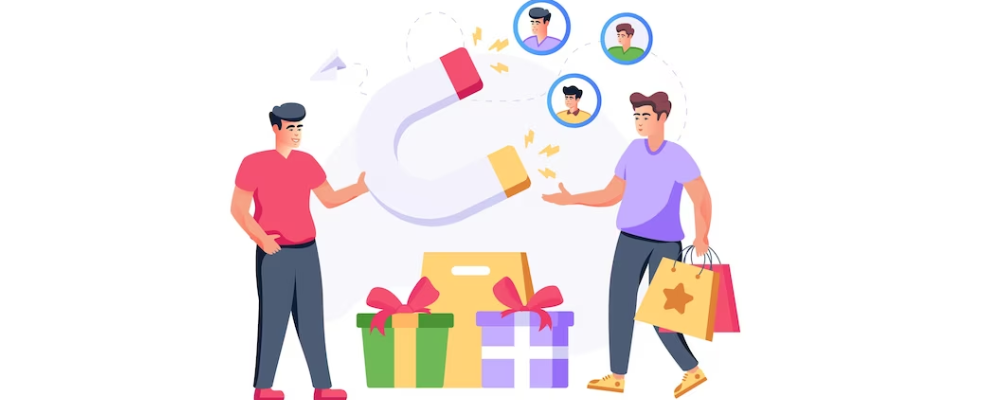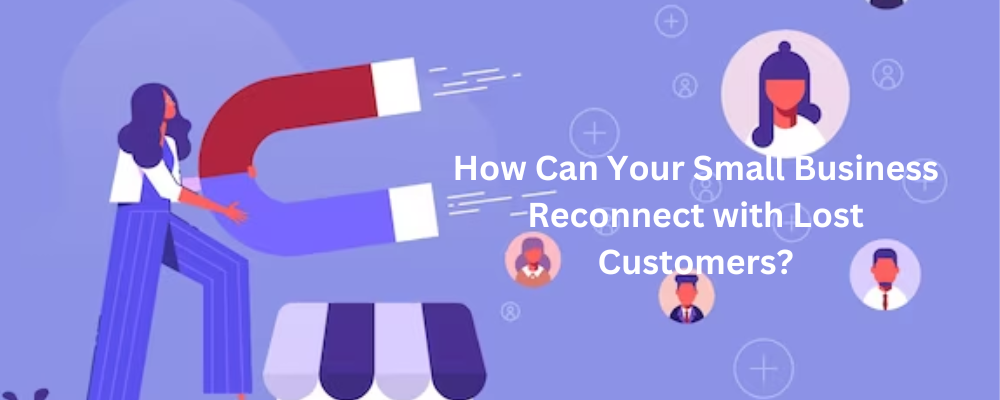In today’s marketplace, the strength of any small business lies not just in acquiring customers, but also in retaining them. However, in the ebb and flow of market dynamics, customers occasionally slip away for various reasons—be it shifting preferences, evolving needs, or unsatisfactory experiences. The art of reconnecting with these lost customers is a strategic imperative that holds immense potential for small businesses seeking sustained growth and heightened profitability.
Think of a database full of past customers, each representing a story, interaction, and a way to revive a business. These lost customers, once patrons who walked through your doors or engaged with your services, hold invaluable insights and latent opportunities. The journey of reconnecting with them transcends a mere rekindling of past transactions; it symbolizes a commitment to customer-centricity, a quest for continual improvement, and an astute recognition of the lifetime value of each patron.
In this intricate dance of reconnection, businesses wield the power to not just win back customers but to forge stronger, more enduring relationships. It’s a journey guided by tailored strategies, personalized approaches, and a profound understanding of what drove these customers away in the first place. It’s about leveraging technology without losing the human touch, crafting compelling narratives that resonate, and offering value propositions that reignite the spark of interest.
Understanding the Importance of Customer Reconnection
Reconnecting with customers holds multifaceted significance for businesses. It extends beyond recovering lost sales; it’s about nurturing enduring relationships. Each reconnected customer signifies more than a transaction – it symbolizes a commitment to their satisfaction, fostering the groundwork for long-term loyalty. Moreover, compared to acquiring new customers, reconnection proves cost-efficient, requiring lower investments while potentially yielding higher returns due to the prior demonstrated interest. Most importantly, re-engagement serves as a feedback loop, offering invaluable insights into the reasons behind customer departure. This feedback becomes a compass for business improvement, guiding enhancements in offerings and addressing unresolved issues, thereby fostering continuous growth and evolution.
Impact on Business Growth
Reconnecting with lost customers significantly impacts business growth on various fronts. Firstly, it cultivates sustained revenue streams by establishing a pool of familiar patrons inclined towards repeated purchases, thus stabilizing income flow amid market fluctuations. Secondly, each reconnected customer elevates the overall customer lifetime value, not only contributing to immediate sales but also holding potential for future purchases and advocacy, bolstering their significance to the business. Moreover, successful reconnection initiatives act as a competitive differentiator, showcasing attentiveness and care that sets the business apart in a crowded market.
These efforts also foster brand loyalty, as reconnected customers, when provided exceptional experiences, often become staunch advocates, strengthening the brand against competitors. Lastly, the act of reconnecting and addressing past issues signifies a commitment to rectifying mistakes and prioritizing customer satisfaction, thereby building trust and enhancing the brand’s reputation, which attracts both previous and new customers through positive word-of-mouth endorsements.

The significance of customer reconnection lies in its multifaceted impact. It’s not just about reclaiming lost revenue; it’s about fostering relationships, leveraging feedback for improvement, ensuring consistent revenue streams, and fortifying the business’s position in a competitive market. Reconnecting with lost customers isn’t merely a transactional endeavor; it’s a strategic move that can significantly bolster a small business’s growth trajectory.
Assessing Reasons for Customer Disengagement
Feedback and Surveys: Actively seek feedback from departed customers through surveys or feedback forms. Analyze responses to pinpoint specific pain points, dissatisfaction with products or services, or any negative experiences that led to disengagement.
Data Analysis: Utilize available data to identify patterns or trends associated with customer departures. Look into purchase histories, interaction logs, or customer service interactions to spot commonalities or recurring issues leading to disengagement.
Direct Communication: Reach out to lost customers personally, if feasible, for candid discussions. This direct interaction can provide qualitative insights that might not surface through data analysis alone.
Learning from Past Mistakes
- Once reasons for disengagement are identified, conduct a thorough analysis to understand the root causes. This could involve examining internal processes, product/service quality, customer service interactions, or even misalignment with customer expectations.
- Implement necessary changes or improvements based on the identified issues. Whether it’s refining product features, enhancing service delivery, or streamlining internal processes, learning from past mistakes involves actively addressing and rectifying shortcomings.
- Equip your team with the knowledge and tools necessary to prevent similar issues in the future. This might involve additional training for staff, empowering them to handle situations better, or revamping customer service protocols to ensure a more positive experience.
- Establish systems for continuous monitoring and feedback incorporation. Regularly assess customer feedback and engagement metrics to adapt and refine strategies, ensuring ongoing improvement and responsiveness to customer needs.
By actively identifying reasons for customer disengagement and learning from past mistakes, businesses can turn these insights into opportunities for improvement. This iterative process not only helps in re-engaging lost customers but also fortifies the business against future attrition by proactively addressing underlying issues.
Crafting a Reconnection Plan
Segmentation is integral to effective reconnection strategies, involving the division of lost customers into segments based on their past interactions, preferences, or purchasing behaviors. This segmentation allows for personalized approaches, ensuring that reconnection efforts resonate distinctly with each segment’s specific needs or concerns. Customized communication further enhances these efforts by personalizing messages with the customer’s name and referencing past interactions or purchases, demonstrating an understanding of their preferences or challenges. Crafting messages that directly relate to their previous engagements fosters a sense of connection. Also, tailoring offers or solutions based on individual customer needs identified through past interactions showcases a genuine effort to address their concerns, making the offer more compelling and relevant to their unique situation.

Utilizing Customer Data for Insights
Delving into past interactions, purchase histories, feedback, and service records is key to understanding customer behavior and preferences, aiding in the anticipation of resonant approaches for each customer segment. Predictive analytics further leverages past data to forecast potential future needs or reasons for disengagement, enabling proactive retention measures. Integrating feedback from previous interactions into the reconnection strategy showcases responsiveness, addressing unresolved issues or incorporating improvement suggestions. The use of Customer Relationship Management (CRM) tools streamlines data analysis and facilitates automated, personalized communications, organizing customer data, tracking interactions, and triggering tailored messages at optimal times for enhanced reconnection efforts.
Communication Tactics for Re-engagement
Reconnecting with lost customers hinges on strategic communication that’s timely, tailored, and genuine.
- Timing is crucial when reaching out to lost customers. Ideally, initiate contact when there’s a reason, such as a new product launch, an exclusive offer, or an event that aligns with their previous interests. However, avoid being overly aggressive or intrusive.
- The method of reaching out also matters. Personalized emails, targeted social media ads, or even a phone call, if appropriate, can be effective. Choose a communication channel that aligns with the customer’s past preferences.
- Crafting messages that resonate requires a deep understanding of the customer. Acknowledge their previous interactions, highlight any improvements made based on their feedback, and express genuine interest in re-establishing the relationship.
- Personalization goes beyond just using their name; it involves referencing their purchase history, past engagements, or any specific preferences they’ve demonstrated. Tailor the message to show that you understand their needs and offer a solution or incentive that addresses their concerns or interests.
Effective re-engagement communication involves thoughtful timing and personalized messaging that acknowledges past interactions while presenting value propositions that reignite the customer’s interest.
Loyalty and Return Incentives
Encouraging customers to return and fostering loyalty often involves presenting them with compelling reasons to re-engage with your business.
Creating Irresistible Offers: Crafting offers that captivate and resonate with customers is essential. It’s not solely about discounts; it’s about offering value. Consider exclusive access to new products or services, bundled packages tailored to their interests, or limited-time deals that create a sense of urgency.
Loyalty Programs and Benefits: Implementing a loyalty program adds an extra layer of incentive for customers to remain engaged. This could be structured around earning points for purchases or engagement, which can be redeemed for rewards or discounts. Personalizing rewards based on their preferences or creating tiers within the program further motivates continued interaction.

By devising irresistible offers and establishing meaningful loyalty programs, businesses can effectively incentivize customers to return while nurturing a deeper sense of connection and commitment to the brand.
Leveraging Technology in Reconnection Efforts
Leveraging technology is instrumental in reconnection efforts. Customer Relationship Management (CRM) tools play a pivotal role in streamlining and enhancing these efforts. These tools act as a centralized hub, storing crucial customer data, interactions, and preferences. They enable businesses to track customer histories, segment audiences, and personalize communication.
Automation further amplifies reconnection strategies by allowing for efficient follow-ups. Automated systems can trigger personalized messages or emails based on specific customer actions or milestones. This ensures timely and targeted communication without overwhelming manual efforts.
CRM tools and automation synergize to facilitate a more streamlined and personalized reconnection process. They empower businesses to reconnect with lost customers in a systematic, efficient, and personalized manner, enhancing the chances of successful re-engagement.
Monitoring and Adjusting Your Reconnection Strategy
Monitoring and adjusting your reconnection strategy is crucial for ensuring its effectiveness and optimizing outcomes. This involves tracking progress and metrics to evaluate the success of your efforts and making necessary adjustments for better results. Tracking progress and metrics entails monitoring various key performance indicators (KPIs) such as re-engagement rates, response rates to reconnection attempts, conversion rates of reconnected customers, and overall revenue generated from re-engaged customers.
These metrics provide insights into the efficacy of your reconnection strategy. Analyzing this data helps in understanding what’s working and what needs improvement. For instance, if response rates are low, it might indicate the need for more personalized or compelling messages. Adjusting strategies based on these insights is crucial. This might involve tweaking communication approaches, modifying offers, refining segmentation strategies, or altering the timing of reconnection attempts. Continual refinement ensures that your reconnection efforts remain dynamic and responsive to customer needs, maximizing the chances of successfully re-engaging lost customers.

Final Thoughts
Building lasting relationships through long-term customer retention strategies requires ongoing and continual engagement efforts. Emphasizing personalized interactions, consistent value delivery, and proactive communication forms the cornerstone of fostering enduring connections. Implementing loyalty programs, soliciting feedback, and adapting based on customer insights contribute to a customer-centric approach, ensuring sustained engagement and loyalty over time. The commitment to understanding evolving customer needs and consistently exceeding expectations lays the groundwork for enduring relationships that transcend transactions.




